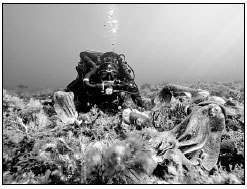据贝尔多夫斯基说,全世界大约有150到300个倾倒生化武器垃圾的地点,他现在在波兰科学院担任海洋化学和生物化学教授。这一数字包括美国海岸线约50个地点,其中相当一部分位于夏威夷。他说:“生化武器垃圾几乎遍布每一片海洋中。”。
There are roughly 150 to 300 sites with dumped chemical weapons worldwide, according to Beldowski, who now works as a professor of marine chemistry and biochemistry at the Polish Academy of Sciences. That number includes around 50 sites along American coastlines, with a significant proportion in Hawaii. “They’re in every ocean and almost in every sea,” he says.
2017年,加利福尼亚州蒙特利市米德尔伯里国际研究所的一组研究人员经过计算发现,静静躺在海底的化学弹药总量达到160万吨。这一数字还仅仅包括已知地点的,他们认为这些地点只占总数的40%至50%。
In 2017, a group of researchers from the Middlebury Institute of International Studies in Monterey, California, calculated that the total amount of chemical munitions quietly lying on the ocean floor reached 1.6 million tons. That number only includes the weapons in known locations—which they believe is only 40 to 50 percent of the total number of sites.
有充分的证据表明这些化学武器已经在泄漏。在波罗的海进行的研究发现,在海星、龙虾甚至商业鱼类的组织中都有有毒残留物。德国水下弹药项目负责人克劳斯·博特彻说,它们已经对德国沿海的鱼类种群造成了严重伤害。
There is ample evidence that these chemical weapons are already leaking. Studies in the Baltic Sea have found toxic remnants in the tissues of sea stars, lobsters, and even commercial fish species. They’ve already taken a toll on fish populations off the German coast, says Claus Boettcher, the director of Germany’s Program on Underwater Munitions.
“我们严重怀疑对鳕鱼繁殖率的影响,鳕鱼是欧洲最具商业价值的物种,”他说,“因为大多数鳕鱼的主要繁殖区都正好位于弹药污染浓度最高的地区。”
“We have a serious suspicion of an effect on the reproduction rate of cod, the most commercial species in Europe,” he says, “because most of the cod’s main reproduction areas are exactly in the same areas where the highest munitions contamination concentrations are.”
如果这些武器不断泄漏或泄漏量增加,它们可能危及已经在全球变暖、污染和海洋酸化中挣扎的生物的生存。
If these weapons keep leaking—or the volume of the leak increases—they could endanger the survival of organisms that are already struggling to adapt to a warmer, polluted, and acidifying ocean.
但是这些有害垃圾的影响不仅仅针对海洋生物,达累奥沃儿童只是一个例子。据致力于保护大西洋东北部的欧洲空间组织委员会的数据,1998年至2009年期间,比利时、法国、德国、爱尔兰、荷兰、西班牙、瑞典和联合王国周围海域发生了近2000次遗弃弹药伤人的事件。
But the effects of these noxious conflict artifacts extend beyond sea creatures, and the Darłowo children were just one example. Between 1998 and 2009, almost 2,000 encounters with abandoned munitions occurred in the waters around Belgium, France, Germany, Ireland, the Netherlands, Spain, Sweden and the United Kingdom, according to the European OSPAR commission, which works to protect the northeastern Atlantic Ocean.
大约60%的事件涉及渔民在他们的渔网中存在弹药。在一个令人伤感的例子中,三名荷兰渔民在二战时期遗留炸弹中丧生,炸弹在他们拖上船时发生爆炸。
About 60 percent of the incidents involved fishermen pulling munitions up in their nets. In one particularly disturbing instance, three Dutch fishermen were killed by a WWII-era bomb that exploded when they hauled it aboard their ship.
